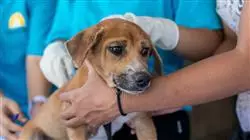University certificate
Scientific endorser

The world's largest faculty of veterinary medicine”
Introduction to the Program
We offer you the most comprehensive training on the market to bring the business management side of your veterinary center to the same level as the clinical and sanitary practice, offering your clients the highest quality in both services"

The veterinary health centers industry has undergone significant structural and paradigmatic changes since the end of the 20th century. These changes have been occurring at breakneck speed over the last decade, catalyzed by the changing context brought about by the last two major crises, the financial crisis of 2008 and the more recent health crisis.
The reality is that the companies in this sector do not have a professional structure outside the veterinary clinical practice, which greatly hinders their growth despite their enormous potential, since keeping pets as companion animals, closely linked to the family nucleus, is an ever-increasing trend in today's society. While it is true that the level of medical and surgical practice performed in these centers is increasingly higher and better, reaching excellence in many cases, in the case of business management it has not been developed professionally to the same extent.
The lack of university specialization in business management in the Veterinary Degree has a great influence on the lack of awareness of the future entrepreneur when it comes to professionally managing a veterinary center, prioritizing, in reality, the medical and surgical practice instead.
The Professional master’s degree in Veterinary Center Management and Administration develops the implementation of business management practices in these facilities in order to improve business profitability. Business management is a discipline with great transversality, encompassing specialties such as finance and marketing, which, although they may seem different, have multiple connections with each other, which become evident when studying these aspects in depth. Throughout the course of the Postgraduate Master's Degree, numerous practical cases are extrapolated from real situations occurring in companies in the sector, so that the veterinary professional can approach them by following the work methodology proposed throughout the course.
At present, one of the main problems affecting continuing postgraduate specialization is its compatibility with work and personal life. Current professional demands make it difficult to provide quality, specialized training in person, so the online format will allow students to combine this specialized training with their daily professional practice.
Immerse yourself in this high quality educational training, which will enable you to face the future challenges of Veterinary Center Management and Administration ”
This Professional master’s degree in Veterinary Center Management and Administration contains the most complete and up-to-date scientific program on the market. The most outstanding characteristics of this program are:
- The development of case studies presented by experts in the management and administration of veterinary centers
- The graphic, schematic, and practical contents with which they are created, provide scientific and practical information on the disciplines that are essential for professional development
- Latest innovations on the management and administration of veterinary centers
- Practical exercises where the self-assessment process can be carried out to improve learning
- Special emphasis on innovative methodologies for the management and administration of veterinary centers
- Theoretical lessons, questions to the expert, debate forums on controversial topics, and individual reflection work
- Content that is accessible from any fixed or portable device with an Internet connection
This Professional master’s degree is the best investment you can make when selecting a refresher program to update your knowledge in Veterinary Center Management and Administration "
Its teaching staff includes professionals belonging to the field of Veterinary Center Management and Administration , who bring to this training the experience of their work, as well as renowned specialists from reference societies and prestigious universities.
The multimedia content, developed with the latest educational technology, will provide the professional with situated and contextual learning, i.e., a simulated environment that will provide immersive learning programmed to train in real situations.
This program is designed around Problem-Based Learning, whereby the specialist must try to solve the different professional practice situations that arise throughout the program. For this purpose, the professional will be assisted by an innovative interactive video system created by renowned and experienced experts in Veterinary Center Management and Administration .
This program comes with the best educational material, providing you with a contextual approach that will facilitate your learning"

This 100% online Professional master’s degree will allow you to combine your studies with your professional work while increasing your knowledge in this field"
Why study at TECH?
TECH is the world’s largest online university. With an impressive catalog of more than 14,000 university programs available in 11 languages, it is positioned as a leader in employability, with a 99% job placement rate. In addition, it relies on an enormous faculty of more than 6,000 professors of the highest international renown.

Study at the world's largest online university and guarantee your professional success. The future starts at TECH”
The world’s best online university according to FORBES
The prestigious Forbes magazine, specialized in business and finance, has highlighted TECH as “the world's best online university” This is what they have recently stated in an article in their digital edition in which they echo the success story of this institution, “thanks to the academic offer it provides, the selection of its teaching staff, and an innovative learning method aimed at educating the professionals of the future”
A revolutionary study method, a cutting-edge faculty and a practical focus: the key to TECH's success.
The most complete study plans on the university scene
TECH offers the most complete study plans on the university scene, with syllabuses that cover fundamental concepts and, at the same time, the main scientific advances in their specific scientific areas. In addition, these programs are continuously being updated to guarantee students the academic vanguard and the most in-demand professional skills. In this way, the university's qualifications provide its graduates with a significant advantage to propel their careers to success.
TECH offers the most comprehensive and intensive study plans on the current university scene.
A world-class teaching staff
TECH's teaching staff is made up of more than 6,000 professors with the highest international recognition. Professors, researchers and top executives of multinational companies, including Isaiah Covington, performance coach of the Boston Celtics; Magda Romanska, principal investigator at Harvard MetaLAB; Ignacio Wistumba, chairman of the department of translational molecular pathology at MD Anderson Cancer Center; and D.W. Pine, creative director of TIME magazine, among others.
Internationally renowned experts, specialized in different branches of Health, Technology, Communication and Business, form part of the TECH faculty.
A unique learning method
TECH is the first university to use Relearning in all its programs. It is the best online learning methodology, accredited with international teaching quality certifications, provided by prestigious educational agencies. In addition, this disruptive educational model is complemented with the “Case Method”, thereby setting up a unique online teaching strategy. Innovative teaching resources are also implemented, including detailed videos, infographics and interactive summaries.
TECH combines Relearning and the Case Method in all its university programs to guarantee excellent theoretical and practical learning, studying whenever and wherever you want.
The world's largest online university
TECH is the world’s largest online university. We are the largest educational institution, with the best and widest online educational catalog, one hundred percent online and covering the vast majority of areas of knowledge. We offer a large selection of our own degrees and accredited online undergraduate and postgraduate degrees. In total, more than 14,000 university degrees, in eleven different languages, make us the largest educational largest in the world.
TECH has the world's most extensive catalog of academic and official programs, available in more than 11 languages.
Google Premier Partner
The American technology giant has awarded TECH the Google Google Premier Partner badge. This award, which is only available to 3% of the world's companies, highlights the efficient, flexible and tailored experience that this university provides to students. The recognition as a Google Premier Partner not only accredits the maximum rigor, performance and investment in TECH's digital infrastructures, but also places this university as one of the world's leading technology companies.
Google has positioned TECH in the top 3% of the world's most important technology companies by awarding it its Google Premier Partner badge.
The official online university of the NBA
TECH is the official online university of the NBA. Thanks to our agreement with the biggest league in basketball, we offer our students exclusive university programs, as well as a wide variety of educational resources focused on the business of the league and other areas of the sports industry. Each program is made up of a uniquely designed syllabus and features exceptional guest hosts: professionals with a distinguished sports background who will offer their expertise on the most relevant topics.
TECH has been selected by the NBA, the world's top basketball league, as its official online university.
The top-rated university by its students
Students have positioned TECH as the world's top-rated university on the main review websites, with a highest rating of 4.9 out of 5, obtained from more than 1,000 reviews. These results consolidate TECH as the benchmark university institution at an international level, reflecting the excellence and positive impact of its educational model.” reflecting the excellence and positive impact of its educational model.”
TECH is the world’s top-rated university by its students.
Leaders in employability
TECH has managed to become the leading university in employability. 99% of its students obtain jobs in the academic field they have studied, within one year of completing any of the university's programs. A similar number achieve immediate career enhancement. All this thanks to a study methodology that bases its effectiveness on the acquisition of practical skills, which are absolutely necessary for professional development.
99% of TECH graduates find a job within a year of completing their studies.
Professional Master's Degree in Management and Direction of Veterinary Centers
.
The great demand for modern veterinary services makes this sector of medicine one of the most relevant today. This situation has generated a substantial growth in the number of clinics and animal care centers recently established, giving way to a competitive business context in the area. Due to this fact, the management of animal health entities stands out as one of the specialties of the veterinary sector with the highest labor demand at present, being its work a determining factor for the commercial success of these care centers. Understanding the need for academic updating that accompanies the growth of occupational opportunities in the area, at TECH Global University we have designed our Professional Master's Degree program in Management and Direction of Veterinary Centers, focused on the training of the professional. In this postgraduate course, special attention will be paid to updating the following aspects: the elements to be considered in the design of the value proposition of a veterinary center according to the characteristics of its customers and the identification of new tools designed to work empathy with the client in veterinary entities.
Study an online Professional Master's Degree on management and direction of veterinary centers
.
Due to the responsibilities of their management processes and the great implications of decision making corresponding to the area, the management of veterinary centers requires the presence of specialized professionals with a high degree of preparation and expertise. In our Professional Master's Degree program, the management of veterinary entities will be approached from the identification of the great challenges and difficulties that are part of the current panorama of the area, contemplating the design of strategies to solve them. In this way, we will focus on the modernization of the following concepts: the current particularities to be taken into account in the control or monitoring of the business plan of a veterinary center and the importance of the implementation of processes for the management of quality in customer service.







